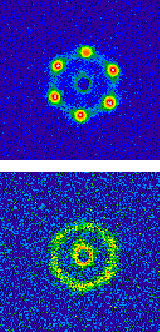Melting in a Superconductor

We would see a lot more high temperature superconducting devices if the materials were capable of carrying a large electric current. The maximum, or “critical current” at zero resistance depends intimately on the properties of so-called vortices, tiny eddies of current that swirl around in a superconductor whenever a large current or magnetic field is present. Vortices can form their own lattice, independent of the material’s atomic structure. Now, in the 22 January PRL, a team shows the first clear structural evidence that the vortex lattice can literally melt or freeze, just like ice or water. They also show that the phase transition is synchronized with a well known spike up in the critical current–confirming once again that manipulation of the vortex behavior will be a key to raising currents through superconductors.
When vortices are present, “a superconductor isn’t a superconductor,” says Jeffrey Lynn of the National Institute of Standards and Technology in Gaithersburg, MD. Moving vortices create resistance to a current flow, so zero resistance only occurs when the material has enough flaws to “pin” the vortex lattice in place–which isn’t usually a problem with real crystals. As a superconductor is warmed, its critical current drops, but researchers have found that over a narrow range of temperatures, the critical current suddenly increases and then decreases again. This “peak effect” is thought to be caused by a “softening” of the warming vortex lattice–with a Jell-O-like consistency, vortices can more easily find pinning sites (defects) in the atomic lattice, which briefly allows more supercurrent to flow.
In the last few years, this lattice softening was shown to be a real melting transition to a “vortex liquid” in high temperature superconductors. But the techniques were somewhat indirect because there is no good way to directly image the vortices at high temperatures in these materials. It was also unclear how the melting was connected with the peak effect–if it was at all–and whether such vortex melting is unique to high temperature superconductors. After all, no one had seen a vortex lattice melt in low temperature superconductors after more than 40 years of studying their vortices.
Sean Ling of Brown University in Providence, RI, Lynn, and their colleagues, hoped to settle these questions by combining their skills in vortex imaging and magnetic susceptibility measurements. (Susceptibility is closely related to the critical current.) They built a susceptometer capable of monitoring a sample while it was also being hit with neutrons to determine the vortex structure.
Using a crystal of niobium (a low-temperature superconductor), the team zeroed in on the narrow region of the peak effect with their susceptometer and–with neutron diffraction–directly observed the vortex melting, which occurred simultaneously. They demonstrated what Ling calls “hallmarks” of the phase transition: supercooling of the liquid and superheating of the solid. Just as ultrapure water can remain liquid below its freezing point–until a small ripple or impurity sparks crystallization–the team showed that the supercooled vortices became solid only after being perturbed by an oscillating magnetic field.
The paper is “a milestone contribution to the field,” says George Crabtree of Argonne National Laboratory in Illinois. “It is the first convincing experiment showing two distinct configurational states that can be reproducibly generated” and clearly suggests a phase transition. In fact, adds Lynn, this phase transition is immune to some of the complications of more familiar solids and liquids. “This could be a prototype system to study melting phenomena in general,” he says.


